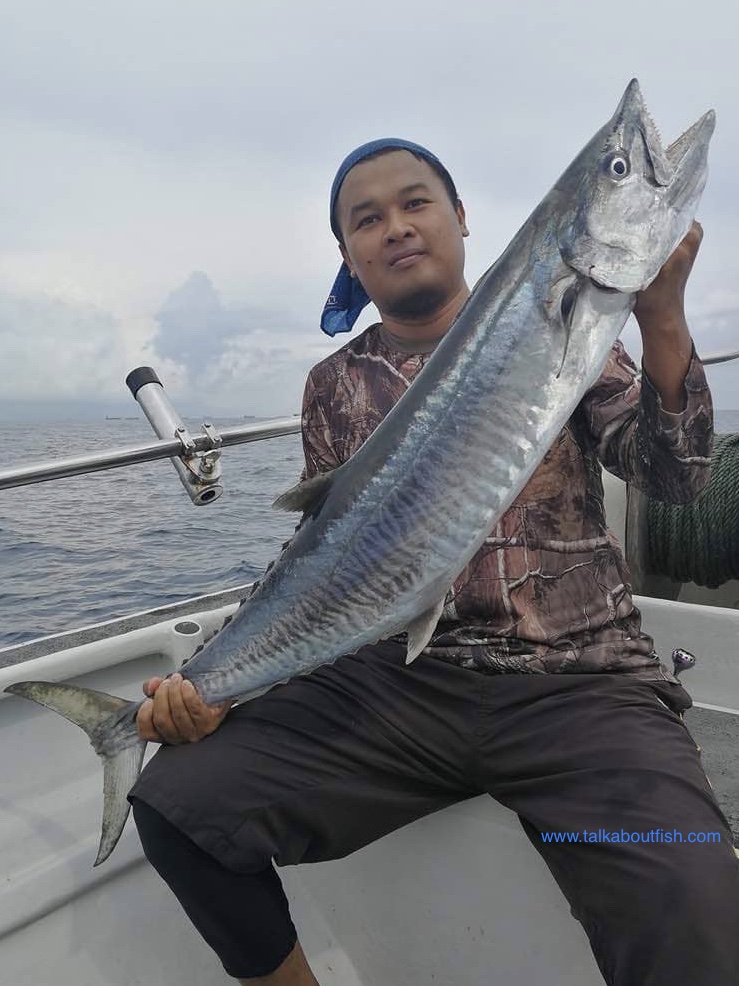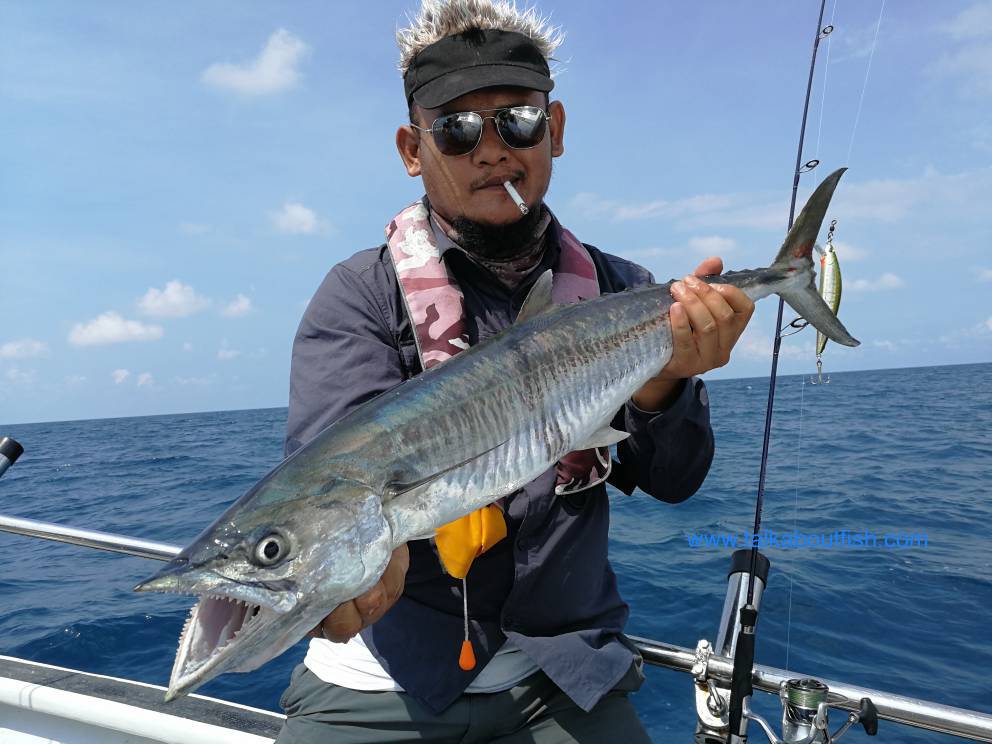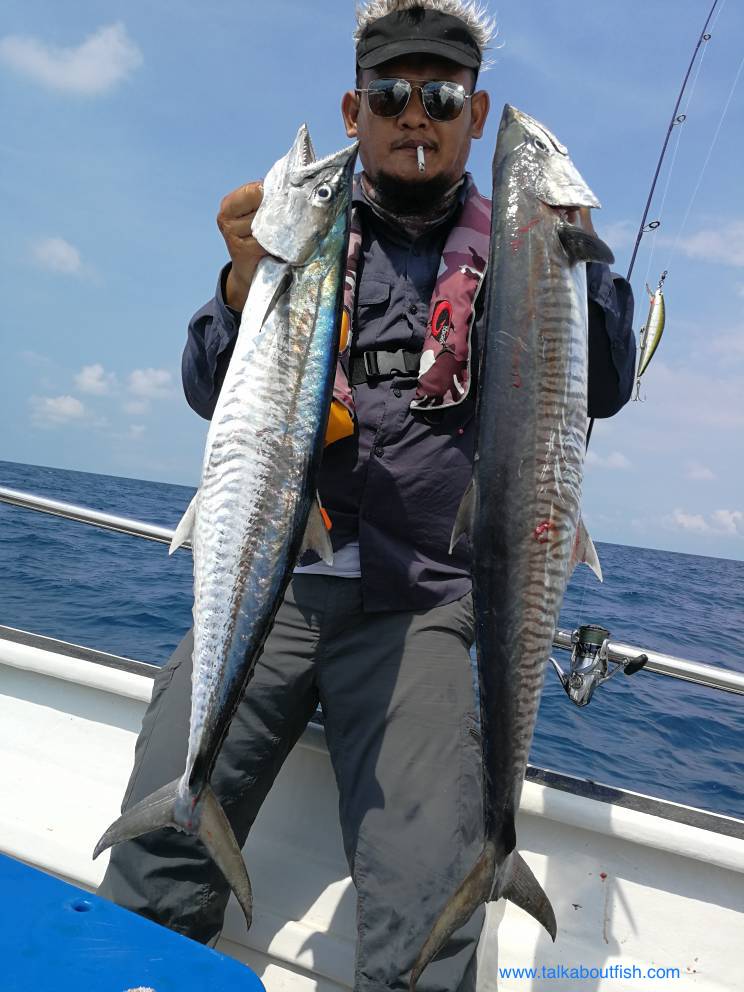Spanish Mackerel: Narrow-barred
Narrow-barred Spanish Mackerel (Scomberomorus commerson) are prized by anglers for their aggressive attitude, fighting action and eating qualities. Their body is dark blue along the top, becoming silvery towards the center and underneath. They have a banded pattern, narrow dark bars running vertically along the body. They are simply called Spanish mackerel or Tenggiri Batang in Malay. Other names for them are Giant Mackerel, King Mackerel, Narrow-banded Spanish Mackerel, Spaniard, Banded Tuna, Leaping Tuna, Tenggiri and Batang.
Spanish Mackerel are surface-dwelling fish that can be found in water as shallow as 15 meters to as deep as 200 m. They are a fast growing species and can reach over 40 cm in length in their first year of life, reaching maturity at two years of age. They can reach 240 cm fork length and over 15 years of age. Usual size caught, however is between 20 to 140 cm.

Spanish Mackerel are ferocious predators and will attack smaller fish like scads, anchovies, herrings, and sardines, as well as any shiny moving objects. They hunt for their prey mostly just below the surface, midway in the water column or sometimes just above the bottom. They are equipped with razor sharp teeth and long narrow bodies adapted to a predatory life in the open ocean.

Adults form groups to feed and spawn in coastal areas. At other times, they disperse to deeper shelf waters but usually remain in the same region. They are diurnal fish but are more active during the day. They usually feed in the morning from 06:00 to 10:00 hour, and late in the afternoon until 22:00 hour. The younger adult fish (1-3 years) consume more food than the older fish.

If there are birds diving and swooping and flying off the surface of the water with food, then it's a sign that something is going on just below the surface. A lot of different surface and mid water predators can cause this activity and one of them is the Spanish Mackerel. These predators school around the smaller fishes to tighten them into a ball shape school near the surface of the water and then take turns eating them.

Spanish Mackerel can be caught using a variety of techniques. Floating live bait on surface or mid water is the technique most often used in Malaysia besides trolling, jigging and casting with metal lures (or spoon). They have razor sharp teeth that can effortlessly slice through their prey and normal fishing line. It is essential that steel wire is used for lures and baits. The drag for the fishing reel must be set loose enough to allow the fish to run without breaking the line. Once hooked, they will dash and pull the line strongly and fast. Keep the line tight enough and do not over tighten reel drag to avoid line break. Many fish are lost when tightening the reel drag when fighting ferocious surface predators and many lost due to loose line. The key of a good tackle setup for Spanish Mackerel is a soft fishing rod (with good lifting power if possible) to keep the line in tension and more than 200 meters of line to allow the fish to run until it tires down.


When come to cooking, they are very versatile. They can be fried, grilled, steamed, or curried. They are undoubtedly delicious no matter how you cook them. They are high in fats and oils such as omega 3, making them a healthy and tasty choice.

Other names for the fish:
Doggie, Kingfish, Macko, Narrow-bar, Narrow-barred Spanish mackerel, Snook, Spaniard, চামপা, মাটিয়া, Champa, Matia, 鰆, 土托, 梭齿, 马加, 康氏馬鮫, 康氏马鲛, Mbassi angou, Indisk kongemakrel, Thazard rayé, Eskomry mkhatat, Vöödiline kuningmakrell, Walu, Thazard rayé indo-pacifique, Indische Königsmakrele, Spanische Makrele, Kan'ad, Ταινιοπαλαμίδα, Teniopalamida, Narrow-barred king mackerel, Kau yue, Mackerel, சீலா, सुरमइ, अंजरी, अंजाइ, तोवार, கோனம், அககுழா, ഐക്കോറ, வெல்லுர, వంజరాము, వరిమెన్, மவுளசியா, வஞ்சிரம், നെയ്മീന്, அக்குல்லா, மவுலாச்சி, மக்குழாச்சீ, வஞ்சீரம், மவுழாசை, வெள்றா, అయొకరు, ചുംബും, સુરમઈ, છપ્રી, కోనెమ, ತಾವರ್, சீலா, Ah-ku-lah, Anjai, Anjari, Ayakora, Ayaokaro, Barred seer fish, Chhapri, Chumbum, King seer, Konam, Konema, Mah-wu-laachi, Mah-wu-leachi, Mavulasi, Seela, Seer fish, Surmai, Thavar, Towar, Vanjiram, Vanjiramu, Varimeen, Vellikannan, Velra, Yellari, వరిమెన్, Calong, Tangige, Tangiro, Tenggiri, Tenggiri batang, Tenggirri, Shir mahi, Yokoshima sawara, Shak abu Isnan, Nguru, Nguru-mtwane, 동갈삼치, Chanaad, ﻲﻧﺎﻤﻳ ﻄﻴﻣﻼﺑ, Balamet yamani, Balameta Yamania, Ango, Angoa, Angoho, Lamatra, Talafeta, Barred spanish mackerel, Dengkeh, Iyot, Lamading, Luding, Narrow-striped king mackerel, Spanish mackerel, Tenggiri bunga, Tenggiri dengkek, Tenggiri papan, Tohok, Tohok dengkek, Tohok langgi, Tohok langi, Bécune blanche, Katonkel barracuda kuda, Tazard, Carita del Indo-Pacifico, Phuzu, Serra, Sombothi, Gros prêtre, Jabang, Kanaad, Ngelngal, Terekrik, Dadayasi, Alumahan, Dilis, Maladyong, Malaudiyong, Sampangarai, Saramulyete, Taguigi, Talang-talang, Tanggui-gui, Tangi, Tangigi, Tangiging-natural, Tangigue, Tangingi, Tanguige, Tanigi, Tanigue, Taniguing batang, Serra-tigre, Dairek, Ispanskaya makrel, Korolevskaya pyatnistayamakrel, Poperechnopolosataya pelamida, Sierra, Uzkopolosaya makrel, Derak, Kanad, Malahau, Yuumbi, Couta, Cuda, Katonkel, King mackerel, Koning-makriel, Carite estriado Indo-Pacifico, Carite estriado Indo-Pacífico, Ahin thora, Anjilava, Arekula, Bambara thora, Striped seer, Thora, Ghazal, Nguru-maskati, ปลาเบกา, ปลาอินทรีย์บั้ง, Insi, Pla ba ka, Pla be ka, Pla in see bung, Thu insi, Sera, Tengiri, Tombak, Tombak balığı, Commerson's mackerel, Cybium, Seer, Kana'd, Khabbat, Barred mackerel, Narrowbarred mackerel, Cá Thu vạch, Narrow barred Spanish mackerel and Katakata
